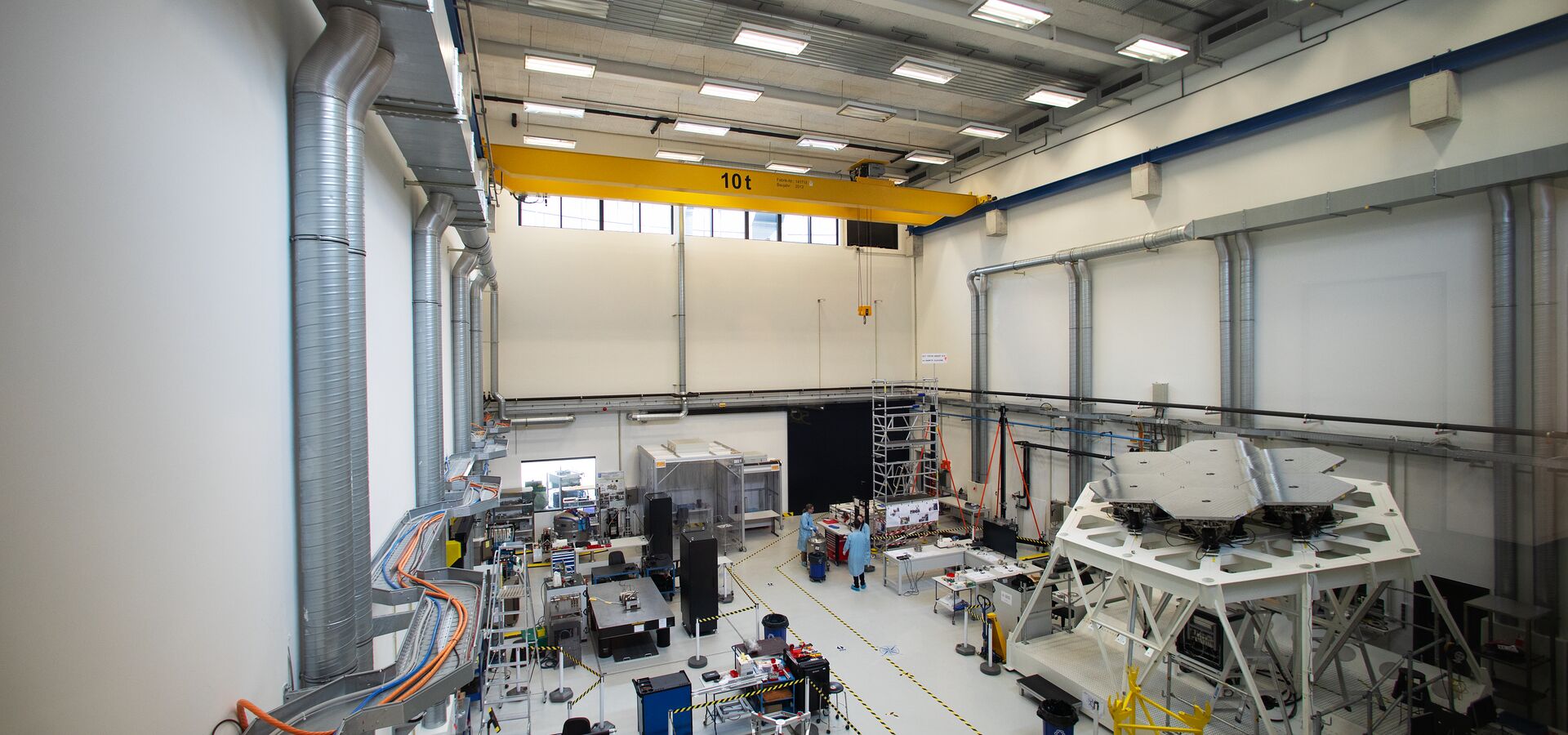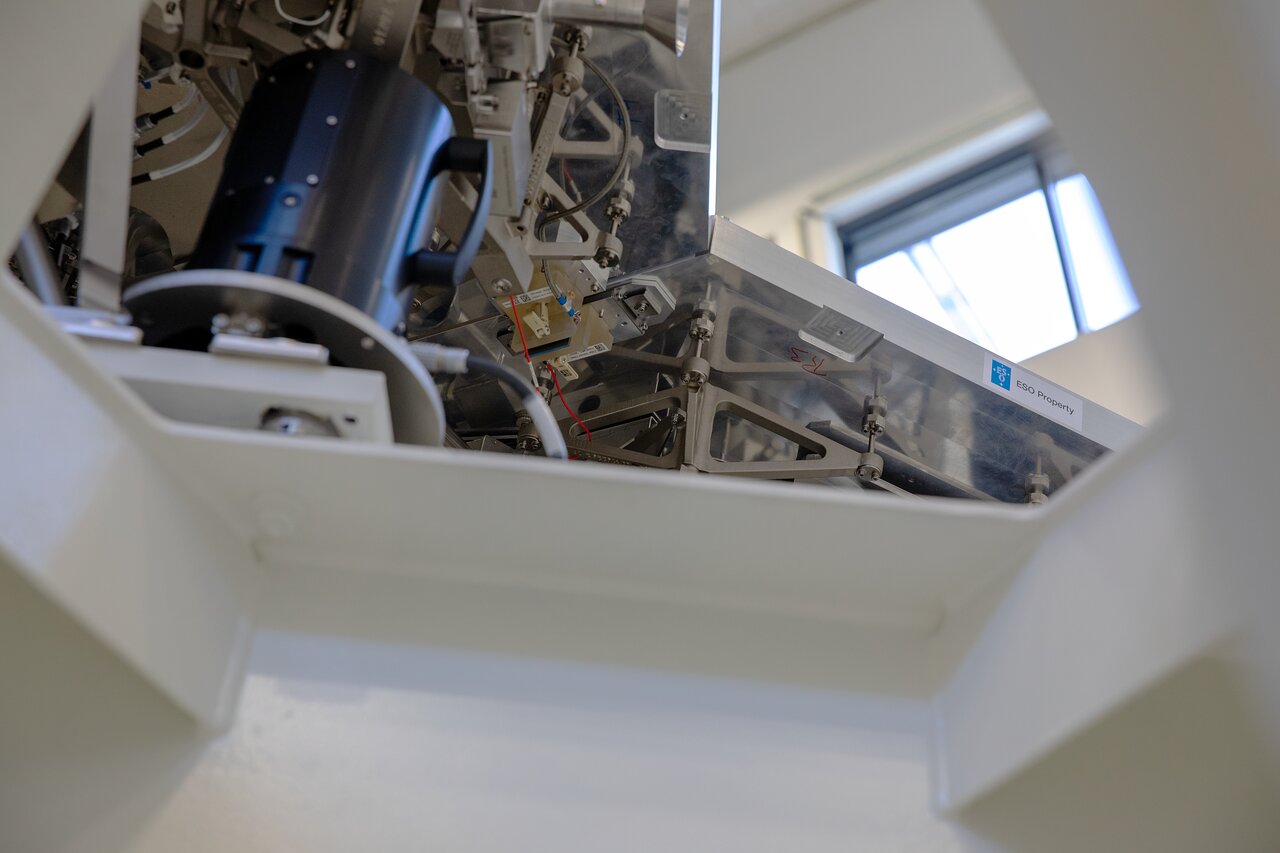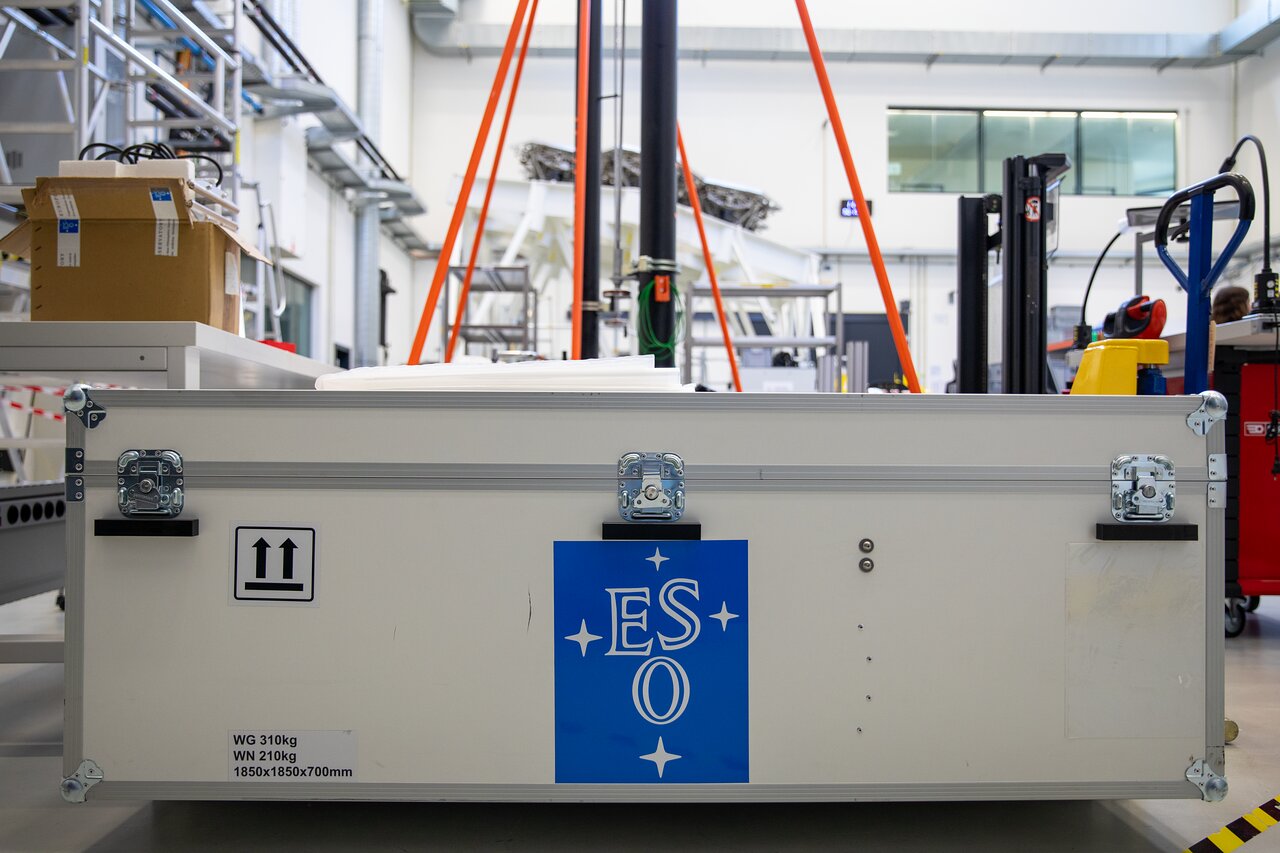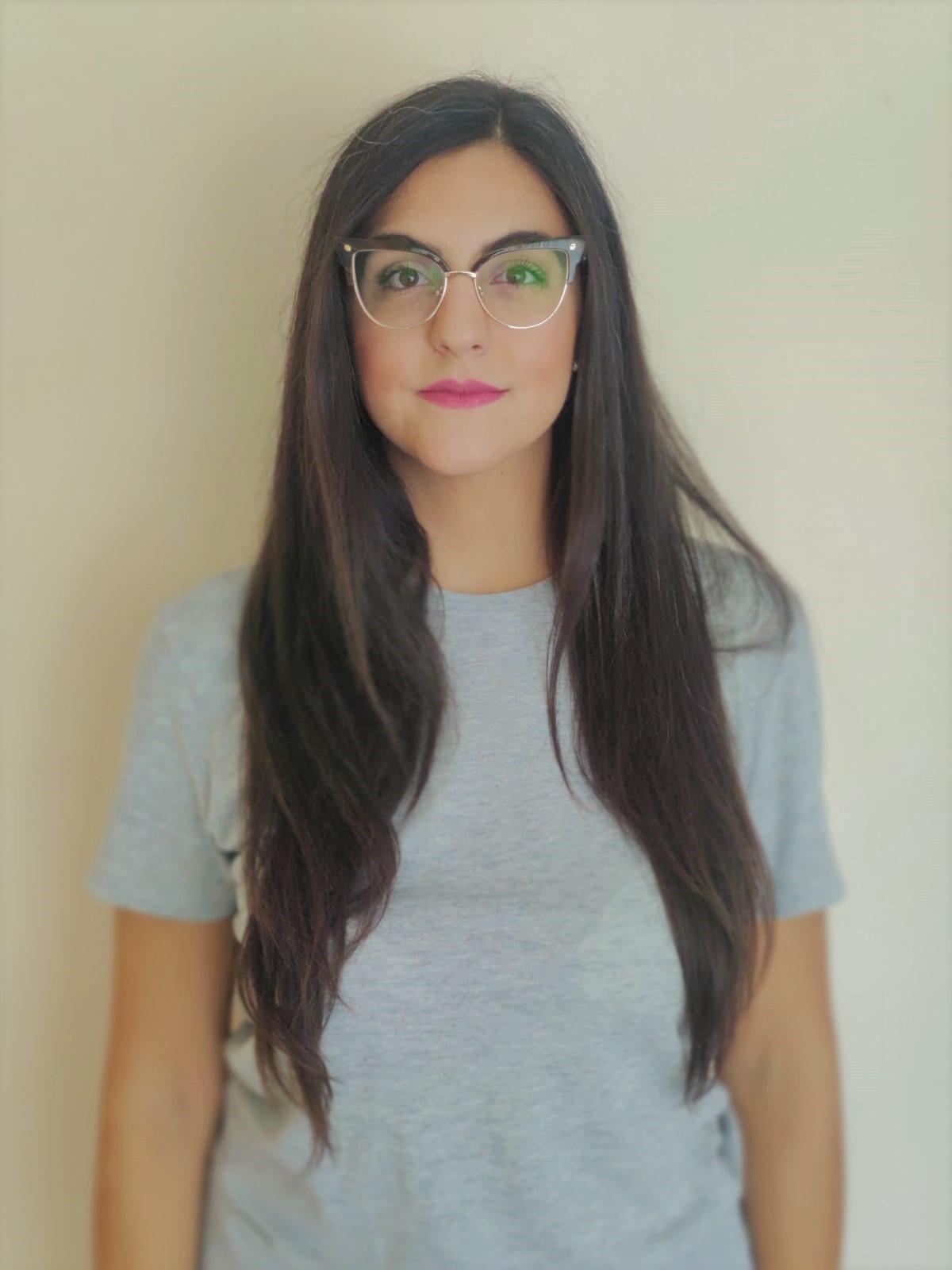- The facility where ESO engineers assemble and test astronomical systems
- Ongoing projects like testing the alignment of the ELT mirror segments
- The engineering challenges of working with such sophisticated devices
It was a sunny morning in Garching, Germany, where ESO headquarters are located. After finishing my coffee I went straight to the so-called technical building, which hosts several facilities including the Large Integration Hall (LIH) –– the heart of ESO technology, where advanced and unique instruments are assembled and tested.
My host was Sebastien Tordo, an optical engineer specialised in integration and alignment of instruments. We met at the first floor, where there is a huge window overlooking the hall. From above, the hall looks stunning: the more you observe it, the more details you can appreciate. Big structures, small instruments, an optical bench, some segments of the main mirror of ESO’s Extremely Large Telescope (ELT), a crane which overlooks the hall and much more.
After a friendly shake of hands, we went downstairs to reach the entrance of the hall at the ground floor.
Before actually entering the room, we put on some special lab coats and a pair of overshoes; we don’t want to contaminate the very delicate equipment being assembled inside. Once inside, I felt very small –– the hall is 21.5 metres long, 16.2 metres wide and 13.7 metres high, a giant –– and incredibly curious. I had admired the hall many times before from the huge windows upstairs, and now I was finally in.
After one hectic year of construction, the technical building was inaugurated in December 2013, and that same year the integration hall hosted ESO’s Christmas party. A good start in the history of this fascinating place. But once the party was over, it was time to get the job done. Today, the LIH hosts many different projects to test and assemble unique instruments and telescope systems that will allow scientists to unveil the mysteries of the Universe.
The first thing I noticed is a structure with some test segments of the primary mirror of ESO’s ELT, arranged in a flower pattern. The flower of segments looks big, but it is made up of only seven segments; I cannot actually grasp how huge the ELT’s 39-m mirror will be, which will consist of 798 of these segments. Each one is about 5 centimetres thick, measures close to 1.5 metres across and weighs 250 kilograms, including its support.[1]
Hard at work at this structure was Philippe Gitton, an ESO engineer involved in the assembly, integration and verification of the ELT’s primary mirror. Philippe explained that the segments will work all together as a single mirror, and this is extremely challenging. The telescope will be moving constantly to observe different parts of the sky, and will be subject to changes in the way gravity affects the structure, as well as wind and variations in temperature. However, the position of the segments and the overall shape across the entire 39-m diameter should be maintained with an accuracy of tens of nanometres – 10 000 times thinner than a human hair. Definitely, an Extremely Large Challenge!
“The segments are mounted on actuators with nanometric accuracy,” explained Philippe. “And between the segments we have edge sensors that measure the gap between them, as well as the lateral and the vertical motion.” This information is fed to the actuators underneath the segments, ensuring that they all work in harmony as a single, massive mirror.
Here they also test how the segments will be inserted and removed from the main mirror. The segments are coated with a reflective layer of silver that needs to be replaced every couple of years. The ELT’s main mirror will have 798 segments, which means that every day two segments will need to be removed to be recoated, and replaced with spares. “To remove a segment we have a central element called an extractor, which lifts the segment vertically by about 40 centimetres,” said Philippe. This exposes three trumpet-shaped tubes from where the segment can be gripped and lifted with a crane, similar to a claw machine. “It’s a robotised system, which will centre itself above the segment, and will be most automatic.”
The ELT segments are not alone here at the LIH. Walking through the hall with Sebastien, I noticed many other instruments and projects. “You can have sort of 20 people working here at the maximum,” explained Sebastien, “but on a day to day basis you have maybe 10 different people coming here.” As a busy place, the space sometimes seems smaller than it actually is.
Coordinating all these activities at the LIH is the responsibility of Christophe Dupuy, an opto-mechanical engineer at ESO, with whom I talked via teleconference. “During the integration phase, a single system needs at least two or three times the footprint that it will have when the instrument is fully assembled,” said Christophe. In addition to this, each project needs its own equipment –– you cannot share your screwdriver here! “Inside the Large Integration Hall, we can end up very quickly with a saturation of space,” explained Christophe, “because in addition to the footprint of the system, for each project we have to foresee the tools, equipment, ladders, forklift...”
Why does each project need its own instruments? “The Large Integration Hall is what we call a clean environment”, said Christophe. “That means that you cannot share the equipment and all the stuff needed must be kept inside this environment.”
A clean room is in fact a well-isolated space with a very low concentration of microscopic solid or liquid particles suspended in the air. To reduce contamination, all the items inside the room can stay only here, and each team has its own instruments as Christophe and Sebastien explained. “A clean room needs a complex filtering and ventilation system to tightly control the temperature and the humidity,” added Sebastien, showing me the several sensors spread all over the hall. Despite being 28 ºC outside when I visited, the thermometers inside marked 20.5 ºC.
As you may imagine, cleaning is fundamental in such an environment, and one of the main characters of this story is a round robot which cleans the floor. It was not so far from us when Sebastien showed it to me. Cleaning is also a tricky process: “At the Large Integration Hall, we work with a precision of nanometres or micrometres, we cannot risk that someone wrongly touches our systems during the cleaning process,” Christophe told me.
When an instrument leaves the LIH, the trip to Chilean Atacama Desert, where ESO’s Observatories are located, isn’t easy. ”For instance, we have to design the boxes that contain the instruments during the trip, including vibration dampeners,” explained Sebastien. “When for example we plan a shipment by boat, we have to also consider humidity and salinity. Inside the boxes we have data loggers to measure humidity, temperature, and vibration shocks. We can record any problem and have a time stamp.”
“One has to keep in mind that what is built in ground-based astronomy is usually a unique instrument or system”, added Christophe. There are no prototypes as happens in the space industry, where different versions can be iterated until reaching the final design. Here, everything has to work from the very beginning, and this influences all the steps of building an astronomical instrument. “We have to already design the system considering that we might not be able to easily replace parts of the instruments,” said Christophe.
Sebastien agrees: “The most challenging part is when you put things together –– it has to work.” And you often encounter problems that aren’t easy to solve. But the engineers at the LIH are up for this task. ”If you have things that you do without a challenge, it's not fun anymore.”
I spent two hours at the LIH, and it was almost time to go back to my office, but I would have liked to ask millions of other questions. One last question popped up in my mind: “What is the thing that you like most about this building?” I asked Sebastien. “What I like most about this building... You can play music…. But when you are alone!”
Notes
[1] The ELT segments are made of Zerodur©, a special glass-ceramic material that is highly stable against changes in temperature. The test segments at the integration hall are made of aluminium, but they have the same mass and shape as the actual ones.
Links
Biography Claudia Sciarma
Claudia Sciarma, a former intern at ESO's Department of Communication, is an astrophysicist in love with writing. Claudia has a Master’s degree in Physics and Astrophysics and attended the Sissa’s Master course in Science Communication. Her main interest are astrophysics, communication, and philosophy. She collaborated as intern with Galileo Museum in Florence and with Media Inaf, the online news outlet of the Italian National Institute for Astrophysics (Inaf). As a science communicator, Claudia writes articles about astrophysics, history of astronomy, and space activities, and she has given talks at scientific outreach events, such as during the International Conference on High Energy Physics.







